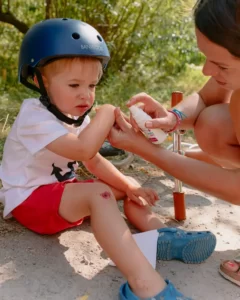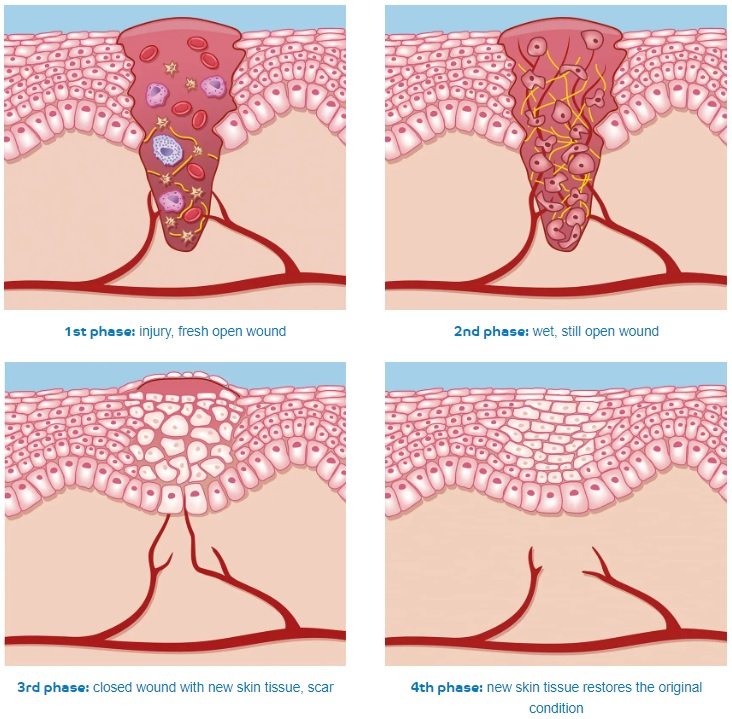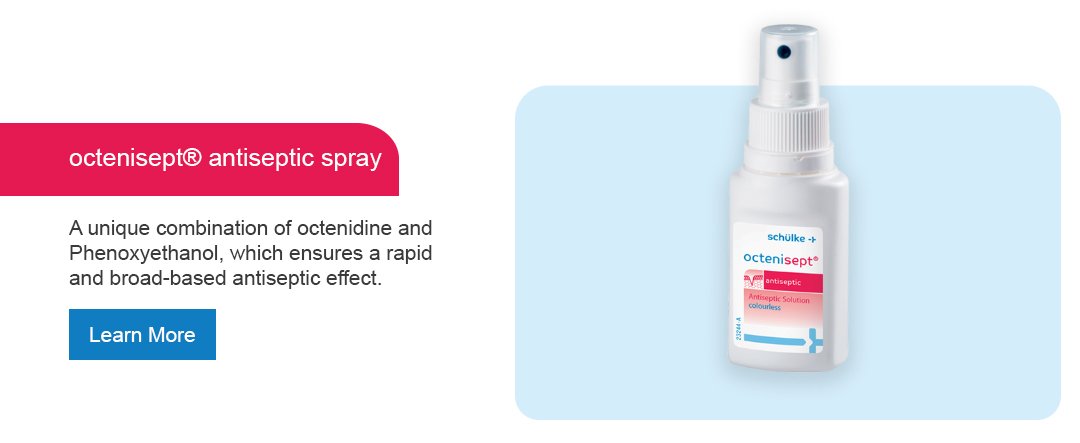Injuries such as scrapes, lacerations, and burns trigger an intricate and immediate healing process in our skin. This piece aims to show how wound recovery works, how to encourage it, and the reasons behind scar formation. We’ll also discuss ways to prevent scars.
Understanding Wound Healing Stages
The primary goal of wound healing is to seal the injured tissue, shielding the body from potential infections, as wounds can act as entry points for many pathogens. Healing commences right after an injury occurs, with numerous cells, signalling molecules, and other elements playing crucial roles.
Wound healing is often categorised into four overlapping stages, varying in duration from one individual to another.
Stages of wound healing include:
Cleaning Phase (Exudation): Blood clots will form immediately after an injury. It effectively acts as a plug to halt bleeding from the injured vessel. The body then secretes signalling molecules such as histamine, which induces a local inflammatory reaction that instigates subsequent healing processes. When the wound exudate cleanses the wound of contaminants, it forms in the vicinity of the injury. Additionally, phagocytes (scavenger cells) travel via blood vessels into the wound to ingest and eliminate damaged cells and bacteria, naturally sanitising the wound. This phase typically lasts one day for superficial wounds and four days for more severe injuries.
Repair Phase (Granulation): From the third to the seventh-day post-injury, the body generates granulation tissue (replacement tissue) to seal the wound gradually. Capillaries extend into the injured area, interconnecting to form a network, and the surface appears granulated. Protein fibres provide a stabilising scaffold, and the wound edges draw together, reducing the wound size.
Epithelialisation Phase: The duration of the epithelialisation phase depends on the wound’s size. Minor injuries to the epidermis disappear within weeks. The capillaries and protein fibres network densifies until epidermal cells migrate from the wound edges, completely sealing the affected area. For deeper wounds reaching the underlying dermis, healing may take months, leaving behind pale scar tissue devoid of sebaceous or sweat glands.
Regeneration Phase: In the final phase, the wound is entirely closed. However, the new skin is still vulnerable to environmental irritants and needs special care, which includes moisture and healing substances.
Scarring: When and Why?
Minor injuries that only affect the top skin layer usually heal without leaving any lasting marks. However, when a wound reaches deeper skin layers, scars often form. The body, unable to regenerate the damaged tissue, creates a replacement tissue. The skin fibres in a scar are parallel rather than the usual network arrangement, making scars less flexible. Additionally, the absence of skin pigmentation renders scars white post-healing.
The Types of Wound Healing
Wound healing can be categorised into primary and secondary types:
- Primary wound healing applies to minor daily injuries and surgical wounds, where wound edges close naturally or with medical assistance using bandages or stitches.
- Secondary wound healing pertains to severe injuries or situations with jagged edges. Here, instead of the wound edges converging, the wound heals from the bottom up with the formation of new tissue, potentially resulting in large, conspicuous scars.
To ensure optimal wound healing, certain conditions must be met. Some factors can obstruct the process, while others can facilitate it. Appropriate wound care is a critical part of this.
Obstacles to Wound Healing
Sometimes, wounds don’t heal as well as they should. The reasons can be diverse.
Factors negatively affecting wound healing include:
- Wound type: Large or deep wounds, dirty wounds, or those containing foreign bodies tend to heal poorly. This can occur in abrasions, cuts, burns, or animal bites.
- Wound location: Wounds in high-tension or high-movement areas, such as joints, often heal slowly.
- Inadequate wound care: Poor wound care, especially keeping wounds dry, can hamper wound healing. Wound infections are particularly detrimental.
Older age, smoking, obesity, underlying conditions like diabetes, or a weakened immune system can also impede wound healing.
Promoting Wound Healing with a Moist Environment
Generally, wounds heal most effectively when they are free from bacterial intrusion and can heal undisturbed. A moist environment expedites wound healing and minimises scar formation. This is because cells responsible for wound closure can proliferate and move especially fast in moist conditions.
Other benefits of a moist environment include:
- It keeps the wound flexible and soft.
- It reduces scab formation.
Additionally, maintaining a balanced diet can aid in wound healing as the body requires increased nutrients like proteins, vitamins, and trace elements during the healing process. Staying well-hydrated promotes blood circulation and the transport of phagocytes, which eliminate bacteria.






